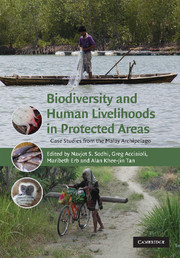Book contents
- Frontmatter
- Contents
- List of contributors
- Acknowledgements
- 1 General introduction
- Part I Conservation needs and priorities
- Part II Conservation with and against people(s)
- 11 Introduction to Part II
- 12 Collaboration, conservation, and community: a conversation between Suraya Afiff and Celia Lowe
- 13 Hands off, hands on: communities and the management of national parks in Indonesia
- 14 Conservation and conflict in Komodo National Park
- 15 Another way to live: developing a programme for local people around Tanjung Puting National Park, Central Kalimantan
- 16 For the people or for the trees? A case study of violence and conservation in Ruteng Nature Recreation Park
- 17 Seas of discontent: conflicting knowledge paradigms within Indonesia's marine environmental arena
- 18 Strategy and subjectivity in co-management of the Lore Lindu National Park (Central Sulawesi, Indonesia)
- 19 Indigenous peoples and parks in Malaysia: issues and questions
- 20 Protecting Chek Jawa: the politics of conservation and memory at the edge of a nation
- 21 Integrating conservation and community participation in protected-area development in Brunei Darussalam
- 22 Conclusion to Part II
- Part III Legal and governance frameworks for conservation
- 29 General conclusion
- Index
- References
14 - Conservation and conflict in Komodo National Park
from Part II - Conservation with and against people(s)
Published online by Cambridge University Press: 12 November 2009
- Frontmatter
- Contents
- List of contributors
- Acknowledgements
- 1 General introduction
- Part I Conservation needs and priorities
- Part II Conservation with and against people(s)
- 11 Introduction to Part II
- 12 Collaboration, conservation, and community: a conversation between Suraya Afiff and Celia Lowe
- 13 Hands off, hands on: communities and the management of national parks in Indonesia
- 14 Conservation and conflict in Komodo National Park
- 15 Another way to live: developing a programme for local people around Tanjung Puting National Park, Central Kalimantan
- 16 For the people or for the trees? A case study of violence and conservation in Ruteng Nature Recreation Park
- 17 Seas of discontent: conflicting knowledge paradigms within Indonesia's marine environmental arena
- 18 Strategy and subjectivity in co-management of the Lore Lindu National Park (Central Sulawesi, Indonesia)
- 19 Indigenous peoples and parks in Malaysia: issues and questions
- 20 Protecting Chek Jawa: the politics of conservation and memory at the edge of a nation
- 21 Integrating conservation and community participation in protected-area development in Brunei Darussalam
- 22 Conclusion to Part II
- Part III Legal and governance frameworks for conservation
- 29 General conclusion
- Index
- References
Summary
Introduction
The preservation of natural areas was historically informed by the early environmentalism that led to the establishment of the world's first national parks in the late nineteenth century. These parks propagated a strict human–nature dichotomy as epitomized by the ‘Yellowstone model’ (Stevens 1997:285), calling for the eviction of resident communities to create areas of pristine wilderness. This model of nature conservation was adopted throughout the Western world and, by way of colonization, globally. Subsequent access and resource-use restrictions deprived communities of their livelihoods, while little was offered in terms of compensation or suitable alternatives. As a consequence many conservation areas are highly contested, harbouring long-lasting – and sometimes violent – conflicts between governments and conservationists on one side, and resource users and resident communities on the other.
With an increasing awareness of this dilemma, the global conservation discourse has undergone a prolonged shift since the 1970s. Alongside the main concern of environmental preservation, social justice emerged as an equally important piece of the puzzle of managing the world's conservation areas. This shift is by now well institutionalized both at a national and an international policy level. The principles laid out in the Convention on Biological Diversity (CBD 1992) are among the most prominent and influential guidelines in shaping current conservation discourse. Alongside the objective of the conservation of biological diversity, the convention prioritizes sustainable use and benefit-sharing of natural resources, with an emphasis on the role played by local communities.
- Type
- Chapter
- Information
- Biodiversity and Human Livelihoods in Protected AreasCase Studies from the Malay Archipelago, pp. 187 - 202Publisher: Cambridge University PressPrint publication year: 2007
References
- 1
- Cited by



